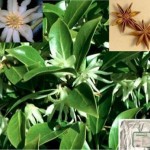 The Star Anise, Illicium verum or Ba Jiao Hui Xiang has been used as a spice and medicine since antiquity. Star Anise is used dried and the seeds have a licorice-like flavor. It’s commonly sold in supermarkets and often used in Chinese cuisine to flavor duck dishes. ( I used it once in my Thanksgiving turkey, it was a hit) It’s also contains the active chemical component in the drug Tamiflu, which is now being stockpiled as a defense against the Swine flu.
The Star Anise, Illicium verum or Ba Jiao Hui Xiang has been used as a spice and medicine since antiquity. Star Anise is used dried and the seeds have a licorice-like flavor. It’s commonly sold in supermarkets and often used in Chinese cuisine to flavor duck dishes. ( I used it once in my Thanksgiving turkey, it was a hit) It’s also contains the active chemical component in the drug Tamiflu, which is now being stockpiled as a defense against the Swine flu.
Star anise was originally in the spotlight because it’s core ingredient was discovered effective as a flu fighter for the Avian flu. Now it’s being touted for the swine flu. In an announcement in Feb 2006 from the University of Tokyo’s Graduate school of Pharmaceutical sciences, they “ found a way to make Tamiflu without using shikimic acid, which is produced from a spice called star anise” The acid is extracted from the pods which wraps the seeds by using a petrochemical ingredient instead of the plant based ingredient. The group, headed by Prof. Masakatsu Shibasaki said the new method would ensure the stable supply of the antiviral drug in the face of surging demand worldwide prompted by fears of a bird flu (AVAIN) outbreak. Although many believe the best way to produce shikimic acid is extracting it directly from the fruit.
“It (Tamiflu) doesn’t prevent the infection, but may decrease its’ severity,” (although there is no scientific data it will prevent H1N1) according to the Tamiflu website. Tamiflu has been on the market since Oct. 1999 and Roche probably never dreamed that this years orders would top 220 million. In the first three years Tamiflu was on the market only 5.5 million doses sold.
Other information from the Tamiflu website said this: “Influenza viruses change over time. Emergence of resistance mutations could decrease drug effectiveness. Other factors (for example changes in viral virulence) might also diminish clinical benefit of antiviral drugs. Prescribers should consider available information on influenza drug susceptibility patterns and treatment effects when deciding whether to use Tamiflu.” (line 155), It continues elsewhere on the site with this, “Efficacy of Tamiflu in patients who begin treatment after 40 hours of symptoms has not been established” and “ Safety & efficacy of Tamiflu in pediatric patients younger than 1 year has not been studied.”
Star anise sells for aprox. $5.00 or less for a few ounces. The best source I found said a dose of Tamiflu contains the equivalent of approximately 13 grams of star anise. That’s a few cents per dose. Studies on guinea pigs yielded evidence that star anise essential oil had a relaxant effect, antispasmodic and bronchodilatory effect on muscarinic receptors. People have traditionally used star anise to reduces gas, relieve minor digestive problems, for headaches and even to promote vitality.
If your interested in drinking star anise as a tea, a typical dose is .5-1 gram of coarsely ground seeds. Cooked at a slow boil (covered) in 2 ½ cups water for a aprox. 30 minutes and then strained. Ground star anise has been traditionally taken in a dose of 3 grams daily. The essential oil of star anise in a dose of 300 milligrams daily has also been reported. The Food and Drug Administration lists star anise as “generally safe for otherwise healthy adults who are not pregnant, nursing or have a preexisting allergy to the herb.” I hope the swine flu fades quietly into oblivion like the Avain flu. Who knows what will happen once weather changes in the fall and winter when flu season is upon us. In any case, if your considering a dose of Tamiflu your armed with some knowledge. Most importantly keep your immune system as strong as possible to avoid any future viruses that abound and remember grocery store shelves can be very beneficial when you know how to shop.


Nice Article.